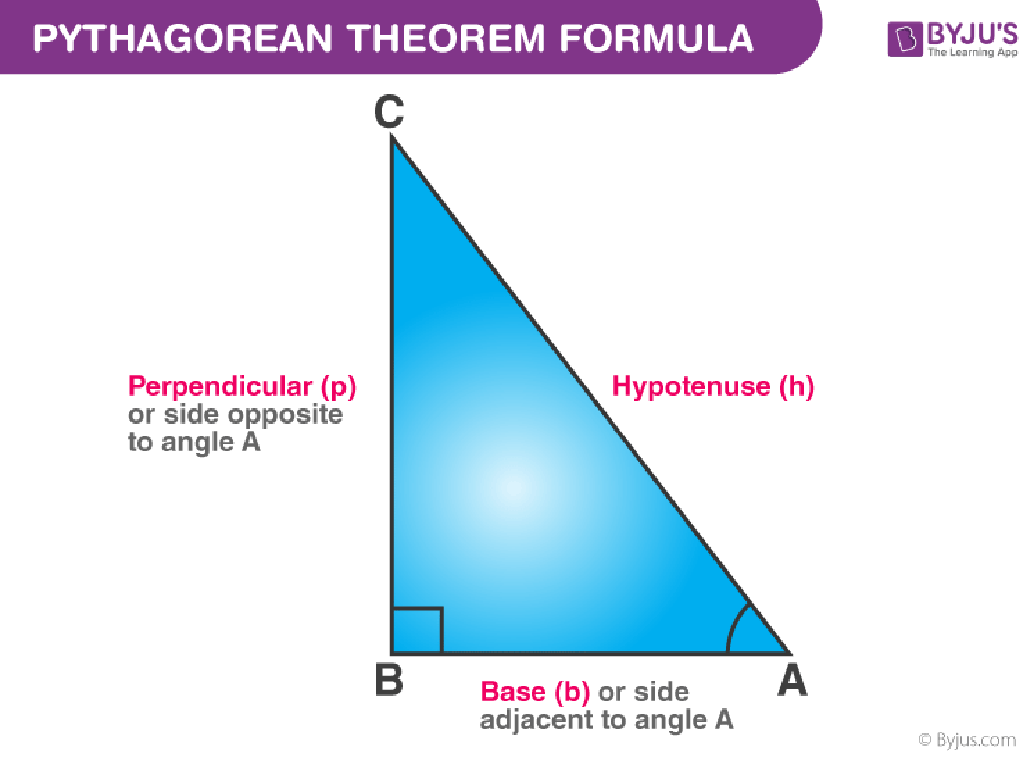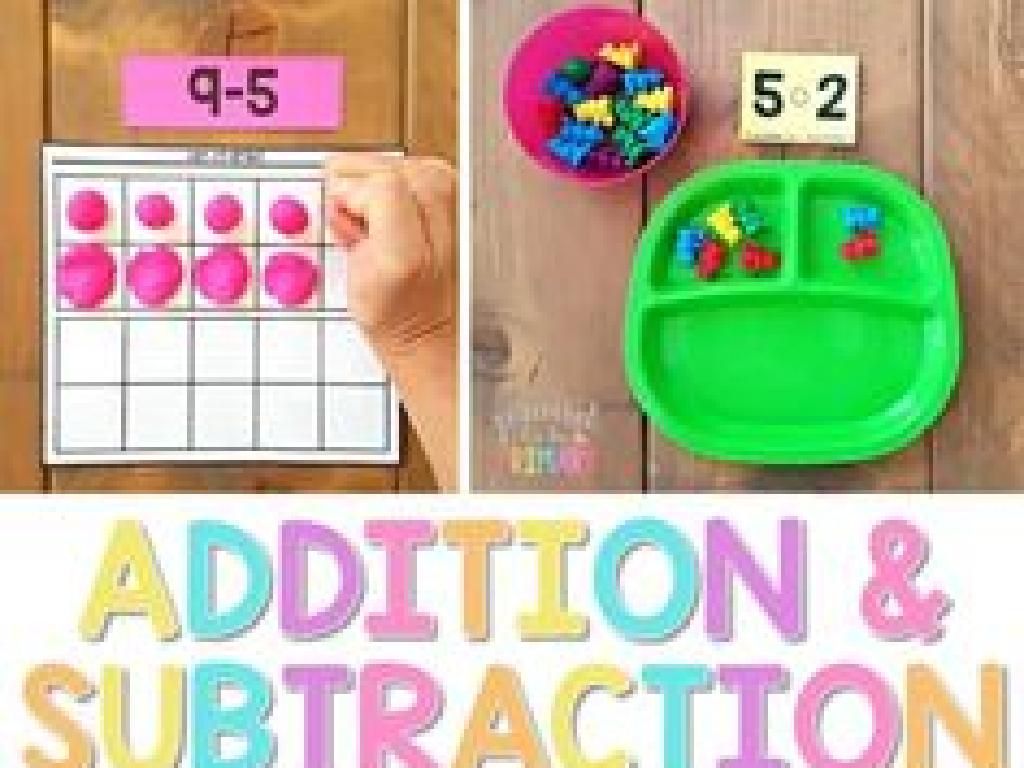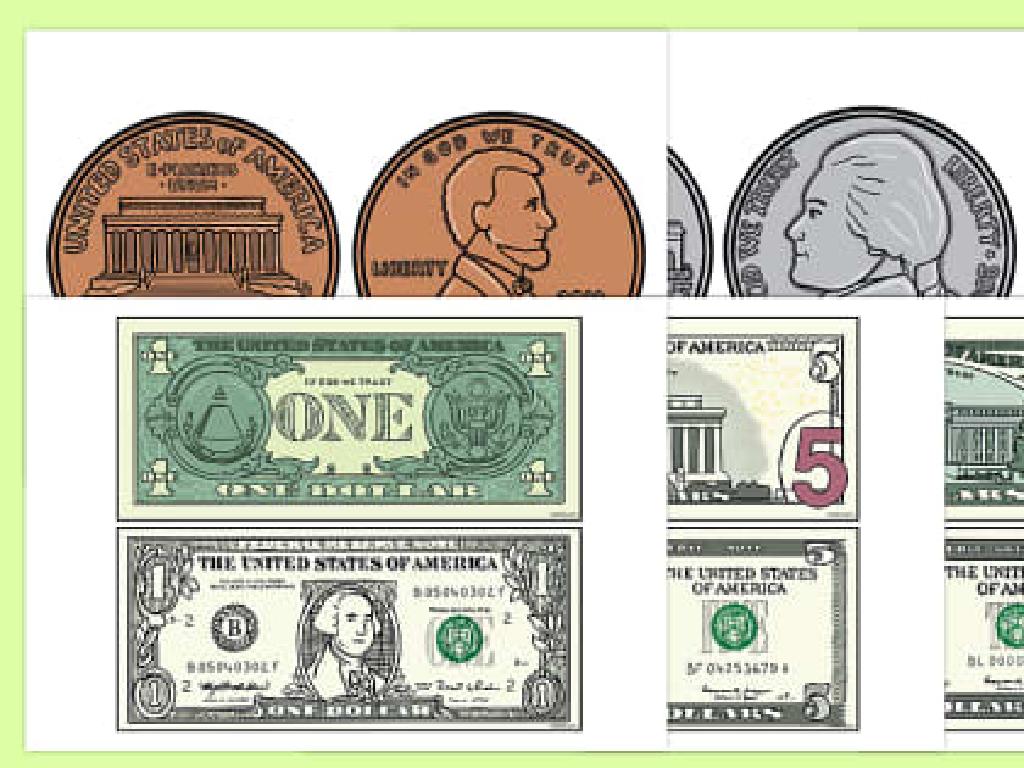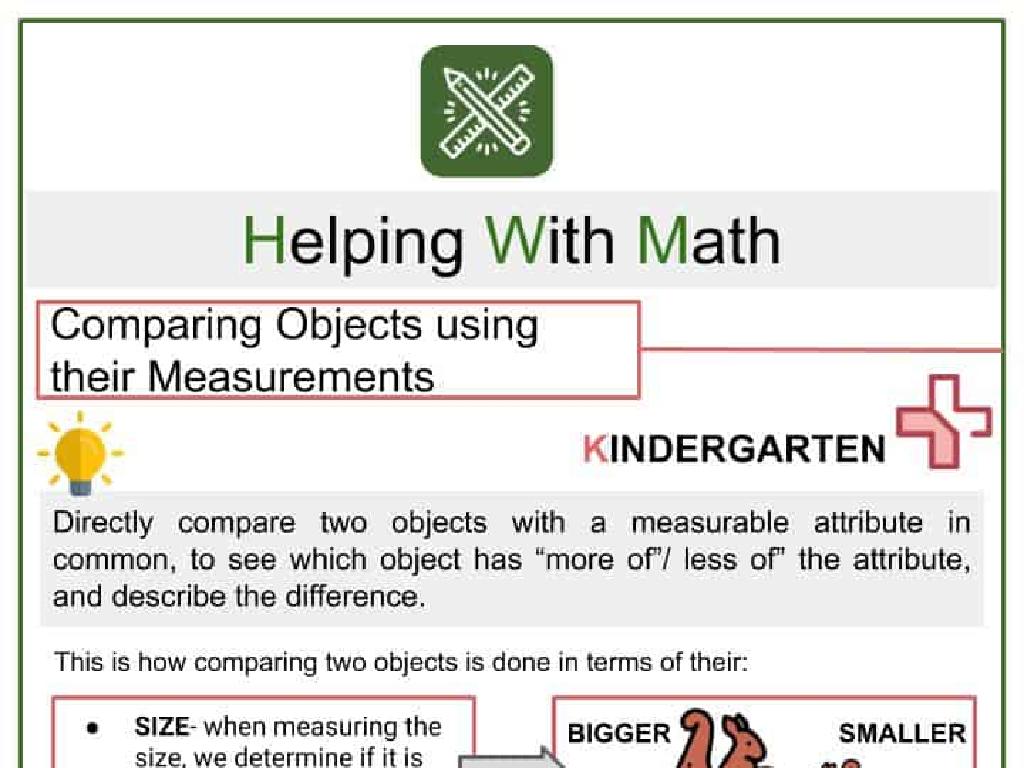Holds More Or Less
Subject: Math
Grade: Kindergarten
Topic: Measurement
Please LOG IN to download the presentation. Access is available to registered users only.
View More Content
Exploring ‘Holds More or Less’
– Learn ‘Holds More or Less’
– Understand container capacity
– Some containers can hold more things, and some can hold less.
– Use eyes and hands to measure
– We’ll look at different containers and guess which holds more or less.
– Fun measuring activities
– We’ll fill containers with water or sand to see which one holds more!
|
This slide introduces the concept of measurement, specifically focusing on the capacity of containers, to Kindergarten students. The goal is to help them understand that different containers can hold different amounts. Encourage the children to use their observation skills and hands-on activities to explore this concept. For example, they can compare two cups of different sizes to see which one holds more water or sand. Activities can include filling various containers with rice or beans, comparing filled balloons, or using toy buckets in a sandbox. These activities will help them grasp the idea of more or less in a tangible and engaging way.
Understanding ‘More or Less’
– ‘More’ means a larger amount
– ‘Less’ means a smaller amount
– Comparing things for more or less
– Use toys to see which has more
– Practice with real objects
– Count items like blocks or crayons
|
This slide introduces the concept of comparison using the terms ‘more’ and ‘less’ to Kindergarten students. Begin by explaining that ‘more’ is used when there is a larger quantity of something, and ‘less’ is used for a smaller quantity. Use visual aids like toys or classroom objects to demonstrate this concept. For example, show a group of 5 blocks and another of 3 blocks and ask which has more. Encourage the students to use the words ‘more’ and ‘less’ to describe what they see. Plan a hands-on activity where students can practice this skill by comparing different sets of items, such as crayons, to reinforce the concept. The goal is to make them comfortable with these terms through repetition and examples.
Let’s Compare: More or Less
– Observe different containers
– Guess which holds more or less
– Use clues like size and shape
– It’s okay to guess wrong
– Learning is about trying and learning
– Practice makes perfect
|
This slide is designed to introduce Kindergarten students to the concept of volume through a fun and interactive guessing game. Show them various containers such as cups, bowls, and bottles. Encourage them to guess which container can hold more and which can hold less, using visual cues like the size and shape of the containers. Reinforce that making mistakes is a natural part of learning and that each guess, right or wrong, helps them understand more about comparing volumes. During the activity, provide positive feedback and guide them to understand why a container holds more or less. This will help them develop their estimation skills and understanding of measurement.
Understanding More and Less
– Comparing two bowls: full vs. empty
– Which bowl holds more?
– The full bowl has more items than the empty one
– Which bowl holds less?
– The empty bowl has fewer items than the full one
– Counting to see the difference
– We use numbers to find out how much more or less
|
This slide introduces the concept of ‘more’ and ‘less’ through a visual and interactive example. Show the students two bowls, one that is full and one that is empty, and ask them to compare the two. Encourage the students to observe and think about which bowl holds ‘more’ and which holds ‘less’. Then, guide them through counting items in each bowl, if applicable, to concretely see the difference in quantity. This activity will help them understand the concept of comparison and quantity in a tangible way. Make sure to use clear and simple language appropriate for Kindergarten students. During the next class, you can extend this activity by using different objects or varying the quantities to reinforce the concept.
Hands-On Activity: Exploring Capacity
– Let’s play with sand and cups
– Which cup holds more sand?
– Fill the cups with sand together
– Carefully pour sand into each cup
– Observe which one holds more
– Look and see, is it the tall one or the short wide one?
|
This hands-on activity is designed to help Kindergarten students understand the concept of capacity in a fun and interactive way. Provide a variety of cups of different shapes and sizes for the students to explore. Demonstrate how to fill the cups with sand and guide them to observe which cup holds more. Encourage them to make predictions before filling the cups and discuss their observations afterward. Possible activities include comparing two cups at a time, using cups that are deceiving in appearance (tall and slim versus short and wide), and letting the students explain why they think one cup holds more than another. This activity will help develop their reasoning and observational skills.
Class Activity: More or Less Game
– Play a game with classroom objects
– Choose two items to compare
– Decide which one holds more
– Use words like ‘bigger’, ‘smaller’, ‘heavier’, ‘lighter’
– Share findings with the class
|
This interactive game is designed to help Kindergarten students understand the concept of volume and capacity in a fun and engaging way. Set up stations with various pairs of containers such as cups, bowls, and bottles. Guide the students to choose two items and use their reasoning skills to decide which one can hold more. Encourage them to use descriptive words like ‘bigger’, ‘smaller’, ‘heavier’, ‘lighter’ to explain their thinking. After they make their choice, they should be given the opportunity to test their hypothesis by filling the items with objects like blocks or water. Finally, have each student share their findings with the class, fostering a collaborative learning environment. This activity not only teaches measurement concepts but also promotes critical thinking and communication skills.
Congratulations on Learning More or Less!
– You’ve learned about more or less
– Use eyes and hands to measure
– Estimating by looking and comparing sizes
– Remember, practice is key
– Keep practicing at home!
– Try measuring toys, snacks, and books
|
This slide wraps up the lesson on understanding the concepts of ‘more’ or ‘less’ in terms of measurement. Reinforce the idea that students can use their observation skills and their own hands to estimate and compare quantities and sizes of objects around them. Encourage them to continue practicing these skills outside of the classroom to become more confident in their ability to measure and compare. Suggest that they can measure things like their toys, snacks, or books to apply what they’ve learned in a fun and practical way. The goal is to make them feel accomplished and to instill a sense of excitement for continued learning and exploration.
Class Activity: Fill and Spill!
– Play ‘Fill and Spill!’ with water
– Predict the first container to spill
– Guess by looking at size and shape
– Discover which holds less
– The spilling container holds less water
– Understand more vs. less concept
|
This interactive activity is designed to help Kindergarten students understand the concept of volume through a fun and engaging ‘Fill and Spill!’ game. Provide a variety of containers of different sizes and shapes. Encourage the students to predict which container will spill first when water is poured into them, thus identifying which one holds less. This will help them grasp the concept of ‘more or less’ in a tangible way. Possible variations of the activity could include using different liquids, comparing containers after they’ve been filled, or even having students design their own containers to test their predictions.






